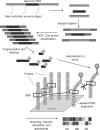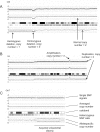Genome-wide Mapping of Copy Number Variations Using SNP Arrays
- PMID: 21049075
- PMCID: PMC2941829
- DOI: 10.1159/000225372
Genome-wide Mapping of Copy Number Variations Using SNP Arrays
Abstract
The availability of high-density single nucleotide polymorphism (SNP) microarrays in recent years has proven to be a great step forward in the context of global analysis of genomic abnormalities in disease. SNP arrays offer great robustness, high resolution and the possibility to detect a variety of different genomic copy number variations such as submicroscopic deletions, amplifications, loss of heterozygosity and uniparental disomy. Moreover, they can be used to perform genome wide association studies. Therefore, SNP arrays harbor several advancements over traditional molecular methods to analyze genomic aberrations, such as cytogenetic analyses, fluorescence in situ hybridization or comparative genomic hybridization methods. Until now, SNP arrays have exclusively been used in experimental research and have enabled seminal new discoveries in many fields by identifying common genomic lesions underlying specific diseases, especially cancer. However, it is foreseeable that SNP arrays will also take up a position in routine diagnostic processes in the future. This review focuses on technical principles of the SNP array technology and their utilization to detect submicroscopic genomic and polymorphic markers associated with disease.
Die Einführung und Anwendung hochauflösender «Single nucleotide polymorphism»(SNP)-Microarrays zur Untersuchung genomischer Aberrationen hat sich in den letzten Jahren als großer Fortschritt für zahlreiche medizinische Forschungszweige erwiesen. Die Genomanalyse mittels SNP-Arrays ist eine einfache und robuste Methode, die in einem Untersuchungsgang die Detektion submikroskopischer genomischer Deletionen, Amplifikationen und uniparentalen Disomien in einer bisher unübertroffenen Auflösung ermöglicht. Darüber hinaus können über eine Genotypisierung hunderttausender Einzelbasenpolymorphismen erstmals genomweite Assoziationsstudien in größeren Populationen durchgeführt werden. Aufgrund dieser Eigenschaften bieten SNP-Arrays zahlreiche Vorteile gegenüber traditionellen molekulargenetischen Untersuchungsmethoden wie z.B. Metaphasenzytogenetik, Fluoreszenz-in-situ-Hybridisierung oder «comparative genomic hybridization». Bisher wurden SNP-Arrays ausschließlich in der experimentellen Forschung eingesetzt und haben dabei bahnbrechende Erfolge durch die Identifikation neuer, krankheitsspezifischer genomischer Veränderungen erzielt. Es ist jedoch abzusehen, dass SNP-Arrays aufgrund ihrer einfachen Anwendung und ihrer hohen Auflösung in Zukunft auch in diagnostischen Routineuntersuchungen eine Bedeutung bekommen werden. Diese Übersichtsarbeit beschreibt die technischen Prinzipien der SNP-Array-Technologie und ihre Anwendung zur Identifikation krankheitsspezifischer genomischer Polymorphismen und Aberrationen.
Figures



Similar articles
-
Combined array-comparative genomic hybridization and single-nucleotide polymorphism-loss of heterozygosity analysis reveals complex genetic alterations in cervical cancer.BMC Genomics. 2007 Feb 20;8:53. doi: 10.1186/1471-2164-8-53. BMC Genomics. 2007. PMID: 17311676 Free PMC article.
-
SNP arrays: comparing diagnostic yields for four platforms in children with developmental delay.BMC Med Genomics. 2014 Dec 24;7:70. doi: 10.1186/s12920-014-0070-0. BMC Med Genomics. 2014. PMID: 25539807 Free PMC article.
-
High-resolution analysis of allelic imbalance in neuroblastoma cell lines by single nucleotide polymorphism arrays.Cancer Genet Cytogenet. 2007 Jan 15;172(2):127-38. doi: 10.1016/j.cancergencyto.2006.08.012. Cancer Genet Cytogenet. 2007. PMID: 17213021
-
Significance of genome-wide analysis of copy number alterations and UPD in myelodysplastic syndromes using combined CGH - SNP arrays.Curr Med Chem. 2012;19(22):3739-47. doi: 10.2174/092986712801661121. Curr Med Chem. 2012. PMID: 22680919 Review.
-
Use of single nucleotide polymorphism-based mapping arrays to detect copy number changes and loss of heterozygosity in multiple myeloma.Clin Lymphoma Myeloma. 2006 Nov;7(3):186-91. doi: 10.3816/CLM.2006.n.057. Clin Lymphoma Myeloma. 2006. PMID: 17229333 Review.
Cited by
-
Genomic copy number variation correlates with survival outcomes in WHO grade IV glioma.Sci Rep. 2020 Apr 30;10(1):7355. doi: 10.1038/s41598-020-63789-9. Sci Rep. 2020. PMID: 32355162 Free PMC article.
-
Clinicopathologic and Molecular Characterization of SMARCB1-Deificient Sinonasal Carcinomas -A Systematic Study from a Single Institution Cohort.Head Neck Pathol. 2025 May 14;19(1):60. doi: 10.1007/s12105-025-01788-w. Head Neck Pathol. 2025. PMID: 40366517 Free PMC article.
-
The 'Whole Genome Age'.Transfus Med Hemother. 2009;36(4):244-245. doi: 10.1159/000228919. Transfus Med Hemother. 2009. PMID: 21049074 Free PMC article. No abstract available.
-
Advancements in copy number variation screening in herbivorous livestock genomes and their association with phenotypic traits.Front Vet Sci. 2024 Jan 11;10:1334434. doi: 10.3389/fvets.2023.1334434. eCollection 2023. Front Vet Sci. 2024. PMID: 38274664 Free PMC article. Review.
References
-
- Botstein D, Risch N. Discovering genotypes underlying human phenotypes: past successes for mendelian disease, future approaches for complex disease. Nat Genet. 2003;33:228–237. - PubMed
-
- Dutt A, Beroukhim R. Single nucleotide polymorphism array analysis of cancer. Curr Opin Oncol. 2007;19:43–49. - PubMed
-
- Yamamoto G, Nannya Y, Kato M, Sanada M, Levine RL, Kawamata N, et al. Highly sensitive method for genome wide detection of allelic composition in nonpaired, primary tumor specimens by use of af-fymetrix single-nucleotide-polymorphism genotyping microarrays. Am J Hum Genet. 2007;81:114–126. - PMC - PubMed
LinkOut - more resources
Full Text Sources

